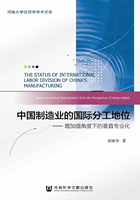
Abstract
Nowadays, countries in the world are linked by the global production sharing and integrated into a huge international vertical specialization system. In this system, different country are in different location, playing different roles and having different status. From the perspective of value added, which is a new angle, the author analyzes the status of international labor division of China's manufacturing.
The export of China's manufacturing grows rapidly with China deeply integrating into the international vertical specialization division system. But the exported goods contain much value created by other countries, which means that China's export has the characteristics of vertical specialization. Under such circumstances, the traditional measures of international division of labor lose its generality. How to correctly measure China's export scale and reasonably judge China's status in the international division of labor are currently important topics. Under the general equilibrium framework, based on the measurement and analysis of“value stream”, the author analyzes the international labor division status of China's manufacturing in the international vertical specialization division system. The structures and contents of this book are as follows.
Chapter 1 introduces the research backgrounds and significances, related researches, research perspectives, framework and methods, major innovations and some directions for further research of this book. Also the author explaines the data used in this book.
Chapter 2 shows the theoretical basis. In this part, the author introduces the basis and motivations of vertical specialization, and builds a general equilibrium analysis framework of two countries, two goods and two factors to analyze the changes of labor division, trade and value added. Theoretical analysis shows that the differences of factor endowments are still the basis of vertical specialization:countries abundant in capital tend to specialize in capital-intensive production stage; countries abundant in labor tend to import the intermediates produced by capital-abundant countries, and engage in labor-intensive production stage such as processing and assembling to produce final products for export. When the price of final product rises, the value added share of labor-abundant countries will reduce, that is to say, countries engaging in production of downstream have disadvantages in the international vertical specialization division system.
Chapter 3 focuses on the basis of China's manufacturing participating in the international vertical specialization division system. In this section, the author analyzes the factors from three aspects: factor endowments, technology and economies of scale, institution and transaction costs. The results show that labor cost advantage, industry clustering, tariff reduction and preferential policies are the incentives for China's manufacturing integrating into international vertical specialization division system.
Chapter 4 is empirical analysis of the degree and the position of China's manufacturing in the international vertical specialization division system. The degree of China's manufacturing integrating into the international vertical specialization division increases rapidly, with the obvious characteristics of high technology. By outlining the chain of vertical specialization division of China's manufacturing and mapping manufacturing's international vertical specialization division network, the author analyzes the position of China's manufacturing in the international vertical specialization division system. The results show that: first, the chain has shifted from“triangle pattern”to“EU/US-China-EU/US pattern”. Second, the international vertical specialization division network is made up of“blocks”, and the blocks are connected by major countries or areas. The network is dynamic, in which China is more and more important. Third, there are four main sectors/industries: coke, refined petroleum and nuclear fuel, chemicals and chemical products, rubber and plastics, electrical and optical equipment,all of which have more influences than other industries in the system of international vertical specialization division. Fourthly, the global financial crisis affected the layout of international vertical specialization division network, and might lead to the adjustment of international labor division.
Chapter 5 is the empirical study on the international labor division status of China's manufacturing from the perspective of“value stream”. The empirical study includes three aspects: first, the author revalues the scale of China's manufacturing exports with the method of trade in value added, and the results show that China's manufacturing export scale shrinks, especially the medium-high &high-technology manufacturing, which reflects that China's status in the international labor division of manufacturing is not so high as measured with the traditional“total export statistical method”. Second, the author measures international competitiveness ot China's manufacturing with the index of CA and CBT which are calculated by using the data of trade in value added, and the results show that the international competitiveness of China's manufacturing is mainly embodied in the low technology manufacturing, the international competitiveness of China's manufacturing(especially the middle and high technology manufacturing)is rising, but is not so high compared with other major countries or area in the international vertical specialization division system, which proves the fact that the international labor division status of China's manufacturing is not high. Third, the author analyzes the factors income of China's manufacturing in the international vertical specialization division system by calculating the GVC income. The results show that China's total GVC income is increasing and can compete with developed economies such as Germany and the US, but measured with GVC income per capita, factors income of China's manufacturing, in total or every type of technologies, are the lowest compared with other major economies, which shows that China's gains in the global value chain come from the high input, so its division status is low.
The last part puts forward the main conclusions and policy recommendations. The status of China's manufacturing is rising in the international vertical specialization division system, but is still low compared with other econom ics. Faced with potential adjustment of international division of labor in the postcrisis era, to promote the international division of labor status of China's manufacturing, the only way is to climb up to the upstream of global value chain and grasp the key linkage in international vertical specialization division system.